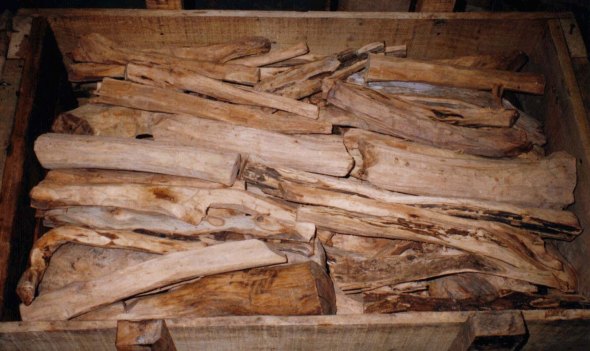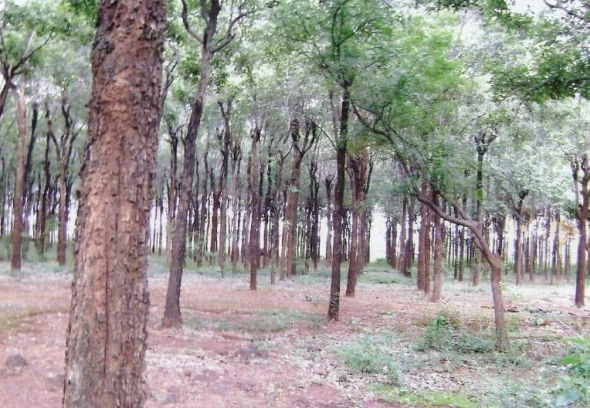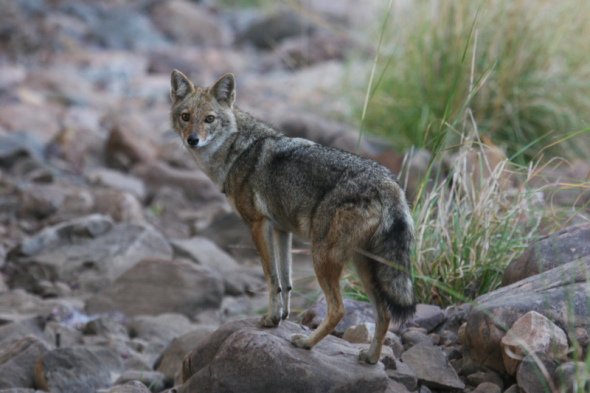Environmentalism Chapter 27 - Sandalwood Smuggling

Concerns are rising over the vast increase in smuggling of the Sandalwood tree deep within the forests of India, Australia and Africa. The trade is now roaring and placing many botanical species of plants and mammalians at risk. Streams and oceans are also polluted from the toxins that are used, plus poaching within these areas is increasing as of roads being opened up that gives the poacher, and the tropical pet trade smuggler an easy route into and out the forests of India.
What is Sandalwood?
Sandalwood is an aromatic tree that is a member of the numerous freeloading plants in the Santalaceae family, particularly the Santalum album. The sandalwood tree is indigenous to India and the specialty of the wood is that it radiates a perfumed scent. Even the wood or timber acquired from the tree is useful in numerous ways. The vital oil extracted from the sandalwood tree is commercially utilized in fragrances and remedies.
The sandalwood tree is partially parasitic and evergreen in nature. A normal sandalwood tree grows approximately up to 30 feet or 10 meters in height. The tree bears leaves that are like lances or javelins. The sandalwood flowers range from light yellow to purple in colour and the fruits borne by the tree are petite and just about black in colour. Over the ages, the aroma of sandalwood has been held in high esteem both in India as well as in China. In fact, for thousands of years, sandalwood is often burnt as incense and has a vital role in all Hindu ceremonies in India. In most parts of the world, the central part of the sandalwood tree is regularly used in the manufacture of perfumes. However, in China this has been used as a remedy for different disorders since approximately 500 A.D.
The Indian sandalwood, also known as the Santalum album, is said to be in danger of extinction hence why it is very costly. Despite the fact that all sandalwood trees in India as well as in Nepal are owned by the respective governments and felling for the trees stringently restricted, many trees are still cut down and smuggled out of these countries by well-linked and highly-placed smugglers. Owing to the steep gap between the supply and demand scenarios, the price of sandalwood oil has skyrocketed to $1000 - $1500 per kilogram during the last five years. It may be mentioned here that there are many nations where trade in sandalwood oil is considered illegal as the authorities there are of the opinion that this is ecologically harmful. The authorities in these countries substantiate their view by saying that making the sandalwood trade legal only helps in encouraging the over harvesting of this valuable tree.

According to the experts as well as the traders, sandalwood grown in the Mysore region of Tamil Nadu in southern India is of the best quality available anywhere. Even the smuggling of the sandalwood trees from this region is said to be the highest. As a consequence, the Tamil Nadu government has undertaken the task of planting new trees with help from international agencies. The move is expected to speed up the economic growth of the region, along with replacing the depleting sandalwood forests there. It may be mentioned here that currently people in Kununurra in Western Australia are growing the Indian sandalwood species or the Santalum album on a very large scale. The sandalwood plantations in the region are so vast that they literally surround the scenic little town of Kununurra on all sides.
Why has Sandalwood smuggling intensified?
International Animal Rescue Foundation © doesn’t personally believe that the illegal trade in Sandalwood has increased simply because of the dwindling tree numbers, or of its requirement’s within the Traditional Chinese Medicine and Indian Medicine trade [TIM] as we are again viewing the same typical pattern with Sandalwood as we are with the Rhinoceros, Elephant and Tiger to many other species internationally.
As explained within the documents of [understanding poaching Doc4 2013] we are viewing the increased smuggling as another form of revenue for the illegal firearms and narcotic trade of which Sandalwood tree logging is funding to great extents.
We cannot pinpoint as yet other areas of concern, however based on evidence and the fact the main kingpin that fronts this trade has made himself viewable to the world within China of which he [has been linked to animal parts poaching] and trade then we are lead to believe that he may [be funding poachers or some form of poaching unit] moving into Africa to then take down the Rhinoceros and the Elephant.
This is still to be fully investigated however we are 95% certain with regards from communication via Nepal and India that this man is somewhat involved within the African poaching trade his name we are [withholding] however one can locate this criminal on the World Wide Web via a simple search. He never leaves China and regularly mocks the Indian environmental and tourism ministers via electronic email and telecommunications.
The illegal smuggling and logging trade with regards to Sandalwood isn’t just confined to India though, the trade has also spread to WA [Western Australia] and Africa from which Chinese ringers are coincidentally behind making colossal amounts of money as I have explained briefly below.
This revenue amassed through the destructiveness off illegal forestry logging then goes back deep within the network of [animal poaching] thus keeping the circle of destruction flowing internationally with no light to be seen yet at the end of the tunnel.

Many musical instruments are made from Sandalwood - Illegally logged or legally logged?
Revenue made from illegal Sandalwood logging;
- For one ton of Sandalwood which is roughly one two trees depending on height and circumference length of the girth the trader would fetch in between $15,000 and $20,000 per ton.
- The opportunist logger/illegal trader would fetch no less than $15,000 per ton which can keep a poor person funded illegally for approximately 3-6 months.
- Just in WA [Western Australia] alone 170 tonnes of illegal sandalwood will fetch the illegal logger/trader $2.5 million. Back in March 2012 this exact quantity was seized from Asian loggers that would off brought to the black market millions of USD.
- Prices have skyrocketed on the black market that saw Sandalwood at only $3,000 a metric ton, this has since increased to $15,000 that’s concerning and if not stopped now and nipped in the bub it will take fifty years or more to bring back these tress to their former state.
Patterns and corruption;
We are viewing the same patterns of smuggling and trade routes with customs officers either being bribed or simply turning a blind eye and allowing critically endangered species of the Red Sandalwood the “most craved after” Pterocarpus santalinus to be loaded upon vast sized container ships of which it’s then exported illegally.
Very few legitimate Indian customs officers are not checking container ships and ports correctly, are too slack with their checks to not even scrutinizing documentation adequately which see’s Sandalwood in the ton load leave port. We are seeing though the exact same patterns with regards to the wildlife trade and narcotics trade of which more action has to be taken by customs.
Smuggling gangs are becoming very intelligent and have been noted strapping intricately a container to the underside of the vessel loaded with Sandalwood/wildlife parts or have welded open a new compartment underneath the ship of which they then store the illegal consignment. This compartment is usually next to the rudder.
This type of smuggling behaviour is relatively new and has been used by narcotic gangs that have smuggled abroad large quantities of contraband underneath vessels in welded/opened up caverns into many international nations. Australia is seeing some large hauls now regarding this type of illegal activity however they have specialist divers and one of the world’s best customs that routinely check these types of vessels both covertly underneath the container vessel and above to within, they also scrutinise the vessels construction plans.
It’s extremely frustrating to know that these methods are being used by smugglers that customs in India are not frequently checking, but more glancing around the ship’s infrastructure with no underwater checks, or blue print analysis.
November 2012 saw a huge consignment seized, of which had it made the Asian border the illegal contraband would of made millions of USD thus funding the black market massively.
Container vessels and ports must now be thoroughly checked with all loop holes closed
The report quotes;
A recent seizure of a container of red that was being moved from the SEZ port of Vallarpadom in Kochi has once again exposed the illegality of exporting this product to various parts of China. It is being alleged that the rare sandalwood was cut and transported through a nexus of smugglers and Naxals from the forests of Andhra Pradesh to other ports with the help of agents.
As many as nine containers, worth about 100 crores, have already passed unnoticed to other countries via this port indicating that there is massive political and organised syndicate smuggling ring operating here.
Government enforcement agencies like the Directorate of Revenue Intelligence (DRI) and the Customs and Excise have complained that they have very little access to these SEZ Ports. - Which we find very hard to believe.
Because the first such SEZ approved port does not allow the entry of enforcement law agencies to conduct checks inside, it helps smugglers to carry on with their illegal operations. The Customs Department has alleged that the terminal is not immune to on-port customs inspections as per Section 47 of the SEZ Act.
The enforcement agencies that arrested the kingpin of the illegal trade Anil Kumar, the driver and few others are dismayed by the fact that they will be released on bail as the Indian law has no provisions against persons who violate the International treaty helping culprits to evade punishment.
Government of India has entered in an international treaty with several countries and to protect the treaty in India there is no law against persons who are violating the international treaty.
The recent Supreme Court order which states that any person of whatever quantum of amount he is evading or whatever the gravity of his offence he is involved the magistrates are bound to release them on bail which has created a very bad situation and has fuelled the Sandalwood trade more.
The Directorate of Revenue Intelligence (DRI) confiscated, in an early morning raid, a container with 17 tonnes of contraband red Sandalwood destined for China through Dubai and Hong Kong from the Vallarpadom ICTT.
The DRI has learned that red Sandalwood worth a minimum of Rs 50 crore had left the ICTT for Dubai to be re-routed to Chinese ports since the commissioning of the terminal in February last year. The contents of the container cleared by the customs as rubber mat last week were filled with red sandalwood on its way to the terminal after getting Customs clearing.
The red Sandalwood is exported mainly to China for making musical instruments due to cheap price and availability in India. The contraband is also used in TCM/TIM and is another method of making money fast such as the illegal poaching and smuggling of wildlife animal parts from Africa.
The smuggling trade is also linked to Kenya – Africa;
The report quoted;
The protected Sandalwood tree is turning traders into millionaires. The plant is being harvested illegally in Samburu, Pokot, Baringo and other parts of the North Rift.
The cartels involved, including prominent politicians, administration and security officials, have made it almost impossible to bring the illegal trade under control, making extinction of the endangered plant a near certainty.
Hardly a week passes without a truckload of the wood, whose scientific name is Osyris lanceolata, [a similar species of rare Sandalwood] being seized is some part of the country.
There are many other cases that are not reported. Perhaps with this in mind, Forestry minister Noah Wekesa a few weeks ago advertised a hotline for the public to inform the ministry of illegal exploitation of the tree that is exported for use in the pharmaceutical and perfume industries.
The toll free hotline number 08002212323 will also provide information on the exploitation of other forest products including bush meat, skins, ivory, and contraband trade in wildlife species.
Protected tree;
It is a follow up of the ban on Sandalwood harvesting imposed by President Kibaki in a gazette notice on April 4, 2007, under the protected tree species law.
Behind the scenes in the battle to save the Sandalwood is the Lusaka Agreement Task Force, an organisation charged with law enforcement operations against illegal trade in both animals and plants. The Task Force says over-exploitation of the Sandalwood and other products in the region may lead to a dangerous imbalance in the ecosystem.
Sandalwood is harvested from trees over 30 years old and unfortunately the tree is valuable from the leaves to the roots hence its vulnerability. The crude methods of harvest destroy the plant completely.
Late last year key Government departments in Kajiado district clashed over a lorry impounded at Namanga border on November 26 while transporting 40 tonnes of sandalwood worth Sh40 million to Tanzania. Area Police, Kenya Wildlife Service and Forest service personnel failed to agree on where the trailer should be kept. It ended up at the KWS staff quarters following pressure from KWS and forest officials. Sources said the KWS officials did not trust the police on grounds that they would be compromised.
The intriguing thing was that both containers had two padlocks one from the police and another from the KWS officials. This shows mistrust in each other’s capacity to keep the containers safe AND corruption.
However Humphrey Wanzala, who was then area police boss at the time, had a different story saying that the lorry was at the KWS quarters because the officials were suspecting that there were other wildlife trophies besides Sandalwood.
He denied that there was mistrust saying, “We are together in this as we work for the same Government. We shall pursue this matter to the very end.”
The KWS official, Mr Timothy Kitonyi, said the only issue was that the suspects claimed they harvested the sandalwood in Mbale, Uganda, yet they did not have any relevant documents. KWS suspected that they may have hidden other trophies in the containers. KWS official were investigating the matter from the headquarters in Nairobi. They wanted to find out how the containers full of Sandalwood had travelled that far without being detected. Three people, Jane Nyambura, Frank Jeremiah Frank and Daniel Muya, were eventually charged with being in possession of East African Sandalwood worth Sh40 million.
Habitat destruction and wildlife;
Illegal harvesting and a lack of effective management are major causes for concern. Even though the trade is regulated through a system of permits by the Convention on International Trade in Endangered Species of Wild Fauna and Flora (CITES), it is believed that more of the aromatic wood is leaving the country through illegal means.
The fragrant tree is also at risk from shrinking habitat due to human encroachment and land conversion impacting the wild populations.
Currently there are no detailed studies done on the species. The current information available is very general. The future of our highly fragrant wood is severely threatened by a rising demand for Sandalwood, problems faced in monitoring harvests and a persistent illegal trade.
Many species of primate, Pygmy Elephants, Asian Elephants, parrots, fish, and more are all being placed in severe risk of endangerment from illegal logging that CITES now needs to urge all 178 nations of the CITES parties to now take further and more stringent action, laws and monitoring must be brought in via customs and excise, ports where large container ships are [immune] from random searches MUST not be immune and these loop holes now immediately extinguished to catch up with these criminals.
International Animal Rescue Foundation © works by tackling the demand not the just the killings, logging and/or smuggling. Hitting the demand hard between the teeth knocks the trade for six and disrupts all channels and levels, however to hit demand hard we need all African and most of Asia on our side. That’s going to take some doing however [there is no such word within our vocabulary as can’t or impossible].
In 2012, a report showed how Sandalwood smugglers were getting richer with impunity inside the 500-acre campus of Bangalore University (40 Sandalwood trees carted away; 50 more hacked, left to wither). And now, alarm bells are clanging again over the city’s largest biodiversity reserve.

Peacocks, Mongoose, Wild Rabbits, Jackals, Leopards, Bengal Tigers and more are all under threat not just via the habitual destruction but [the roads and pathways that are being opened up by the loggers] of which the poachers make a quick kill and vast sums of money. The snares and traps are similar to the ones Haryana-based poachers had laid at Biligiri Ranga Temple (BRT) wildlife sanctuary and which were discovered in July 2012.
The snares where made of material similar to clutch cables in motorcycles, they were laid in artificially created cavities to trap wildlife. This is the first time that such snares have been found within the campus. This indicates to us International Animal Rescue Foundation © that Sandalwood logging is out of control, habitat is being destroyed on colossal levels thus pushing wildlife into public areas making poaching easy game.
These snares are said to be common among poachers. They are usually camouflaged and around five or six are placed together in paths frequented by wild animals. The method does not leave a trace after the animals are killed. The products are then sold illegally over international borders.
The Indian government quoted “It is the responsibility of students to protect the flora and fauna they are blessed with. As government departments are involved in blame games, students on the campus should bring about a change and keep poachers and Sandalwood smugglers at bay,” Maheshwar H, a local resident said”

[We ourselves disagree and with the poachers being armed and becoming more intelligent by the day of which a member of the public is soon is going to fall prey to a poaching incident] leading to a loss of human life.
Will the government and CITES act then?
Who knows, what we do know is that should this trade not be hit hard on the head NOW then we are going to see a massive decrease in animal life, possible extinction of Indian big cats, to a possible human death.
We are already more than aware that in India alone big cats are being pushed into residential areas as of their own living areas being destroyed. ACTION must be taken NOW.
International Animal Rescue Foundation INDIA
Director & Indian Delegate of Affairs
For more information please email us of visit our Indian Facebook page that represents the NGO in India, please also stay tuned for our new relation in Nepal.
https://www.facebook.com/pages/International-Animal-Rescue-Foundation-World-Action-India/231030816962522?fref=ts
Encompassing India – Battling the illegal trade baron – Protecting our Flora and Fauna
The illegal smuggling trade seen below in a more different view. The smuggling trade is all around us, it is common fact that every day of your life you will come within only 10 feet of an illegal smuggling operation, by road, train, boat, plane, even in the streets. The smugglers are dressed just like us, they can even be high profile persons[s] to even selling to you WHAT YOU THINK is legal just to be stopped at customs/police [then YOUR questioned for racketeering] DON’T be a victim off crime.
Video below is a little “Bollywood” (spoof) at the start however it does get into the real deal within 1.4 minutes, showing a shocking case of a tree that is near to extinction, and exactly how bad this problem is within India.




